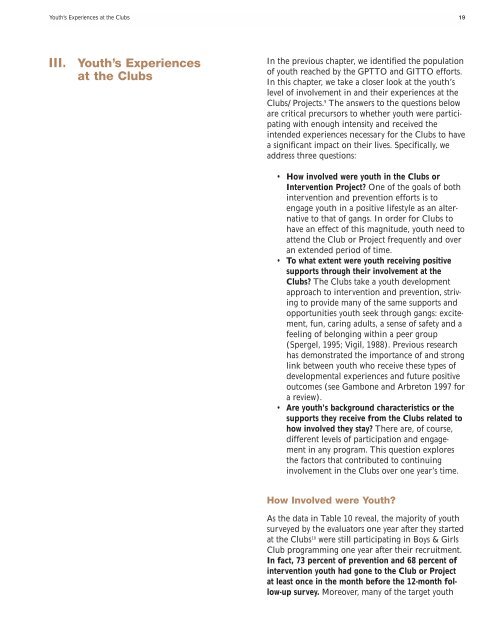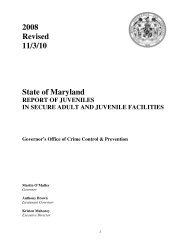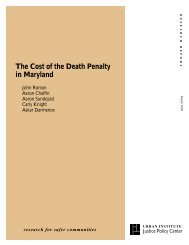Targeted Outreach - Governor's Office of Crime Control & Prevention ...
Targeted Outreach - Governor's Office of Crime Control & Prevention ...
Targeted Outreach - Governor's Office of Crime Control & Prevention ...
You also want an ePaper? Increase the reach of your titles
YUMPU automatically turns print PDFs into web optimized ePapers that Google loves.
Youth’s Experiences at the Clubs 19<br />
III.<br />
Youth’s Experiences<br />
at the Clubs<br />
In the previous chapter, we identified the population<br />
<strong>of</strong> youth reached by the GPTTO and GITTO efforts.<br />
In this chapter, we take a closer look at the youth’s<br />
level <strong>of</strong> involvement in and their experiences at the<br />
Clubs/Projects. 9 The answers to the questions below<br />
are critical precursors to whether youth were participating<br />
with enough intensity and received the<br />
intended experiences necessary for the Clubs to have<br />
a significant impact on their lives. Specifically, we<br />
address three questions:<br />
• How involved were youth in the Clubs or<br />
Intervention Project? One <strong>of</strong> the goals <strong>of</strong> both<br />
intervention and prevention efforts is to<br />
engage youth in a positive lifestyle as an alternative<br />
to that <strong>of</strong> gangs. In order for Clubs to<br />
have an effect <strong>of</strong> this magnitude, youth need to<br />
attend the Club or Project frequently and over<br />
an extended period <strong>of</strong> time.<br />
• To what extent were youth receiving positive<br />
supports through their involvement at the<br />
Clubs? The Clubs take a youth development<br />
approach to intervention and prevention, striving<br />
to provide many <strong>of</strong> the same supports and<br />
opportunities youth seek through gangs: excitement,<br />
fun, caring adults, a sense <strong>of</strong> safety and a<br />
feeling <strong>of</strong> belonging within a peer group<br />
(Spergel, 1995; Vigil, 1988). Previous research<br />
has demonstrated the importance <strong>of</strong> and strong<br />
link between youth who receive these types <strong>of</strong><br />
developmental experiences and future positive<br />
outcomes (see Gambone and Arbreton 1997 for<br />
a review).<br />
• Are youth’s background characteristics or the<br />
supports they receive from the Clubs related to<br />
how involved they stay? There are, <strong>of</strong> course,<br />
different levels <strong>of</strong> participation and engagement<br />
in any program. This question explores<br />
the factors that contributed to continuing<br />
involvement in the Clubs over one year’s time.<br />
How Involved were Youth?<br />
As the data in Table 10 reveal, the majority <strong>of</strong> youth<br />
surveyed by the evaluators one year after they started<br />
at the Clubs 10 were still participating in Boys & Girls<br />
Club programming one year after their recruitment.<br />
In fact, 73 percent <strong>of</strong> prevention and 68 percent <strong>of</strong><br />
intervention youth had gone to the Club or Project<br />
at least once in the month before the 12-month follow-up<br />
survey. Moreover, many <strong>of</strong> the target youth

















